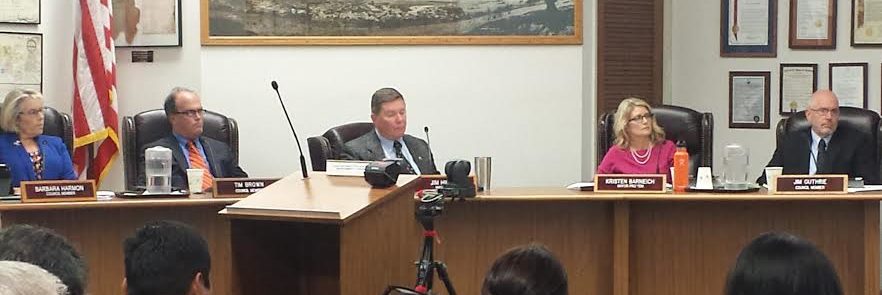Serious issues overlooked in Arroyo Grande EIR
October 29, 2016
OPINION by JAN SHEPHERD
This opinion piece focuses on my concerns with the Environmental Impact Report (EIR) for the East Cherry Avenue and Traffic Way project in Arroyo Grande and lists out the impacts in the EIR that were not mitigated or deemed significant.
Overall, an EIR is written and submitted to ensure project mitigation for all parts of a specific project. If the EIR is not able to mitigate three or more identified significant impacts, the project cannot move forward.
The EIR found only one significant impact, and that was to traffic. The report basically concluded that the impacts were significant because they were not mitigatable.
This is not only issues with the traffic portion of the report. There is missing research from the EIR consultant and the traffic consultant including what impacts to the current non-conforming intersections at Traffic Way and East Branch at Highway 101. The intersections do not meet current city standards or CalTrans standards for safety or for site distance and are classified as F.
A stop light was proposed to assist in mitigating traffic congestion at Traffic Way and Fair Oaks and roundabouts were proposed to mitigate traffic congestion at East Branch and Highway 101. Neither of these options were presented to CalTrans for review and input. However, both proposals directly impact and affect Caltrans right-of-ways.
Additional issues regarding the roundabouts in particular present issues with the actual construction of them—several established retail properties would have to be absorbed and acquired in order to build the roundabouts as there is currently not enough room to construct them.
Arroyo Grande city policy classifies agricultural land as prime. When you lose agricultural land, it is considered a significant impact.
The EIR for the East Cherry and Traffic Way chose not to incorporate our city’s policy regarding agricultural land. John Mack, at a Planning Commission meeting, asked about the application of the LESA standard. This standard is used to determine the total value of a specific site for agriculture.
In short, how this standard was applied to the land on East Cherry and Traffic Way overrides our own land use policy. Given that our land use policy is the strictest standard which should be followed, it seems as though the LESA standard was applied inappropriately and that the EIR findings are inappropriate in that they do not identify the loss of the agricultural land as a significant impact.
The impact of the East Cherry and Traffic Way project to our water supply was also not deemed as significant.
The EIR consultant elected to evaluate impacts to our water as if there are no issues related to our current supply. When questioned by John Mack about the methods used, the consultant stated that you don’t need to take a snapshot in time, but agreed that time would be a relevant factor based on a duration of several years.
So, what has been the trend in the last seven to 10 years? Our rainfall has significantly decreased, impacting our current supply, yet the consultant did not look at this span of time. Any added demand would be a significant impact when there is only 18 months of water left in Lopez Lake.
Two other areas not addressed by the EIR and the potential and real impacts to the city include impacts to the police department and the sewer system.
The EIR consultant said they connected with the police department to find out more information about the potential impacts to the police department with the development proposal.
However, when John Mack reached out to the police department, and spoke with the chief, the chief stated that no conversation had been held with the developer or the EIR consultant with regards to impacts the development could have on the department. The chief further stated there would be an impact based on the type of hotel being proposed. It is difficult to discuss this area because no solid data or information was collected with regards to the potential impacts.
The sewer system was an area not discussed at all by the EIR or the consultant. The South San Luis Obispo County Sanitation District, until recently, was being grossly mismanaged and maintained. With a new plant manager, the maintenance of the plant and its operation is making up for the past.
However, the plant is in need of repairs and upgrades to ensure the affluent passing through the system is processed efficiently and effectively—with additional demands placed on the plant by building in Oceano, Grover Beach, and Arroyo Grande, an additional 51 homes, an additional new hotel with 100 rooms, the plant could reach a tipping point and not be able to meet the demands placed on it.
Again, the EIR does not address this at all. If you remember, there was a spill in 2010 at the plant, are we waiting for that to happen again in order to determine there is a significant impact on the sewer system?
Since this project has been brought forward to the Planning Commission, citizens in Arroyo Grande have expressed their increasing concerns, however, the commission in a 3-2 vote, certified the EIR. Two commissioners, John Mack being one of them, were not comfortable certifying the EIR given the questions and issues the report failed to address and mitigate.
We should all question whether or not there are three or more significant impacts and continue to voice our concerns to the current AG City Council and city staff.
Jan Shepherd has lived in Arroyo Grande for the past 37 years.







The comments below represent the opinion of the writer and do not represent the views or policies of CalCoastNews.com. Please address the Policies, events and arguments, not the person. Constructive debate is good; mockery, taunting, and name calling is not. Comment Guidelines